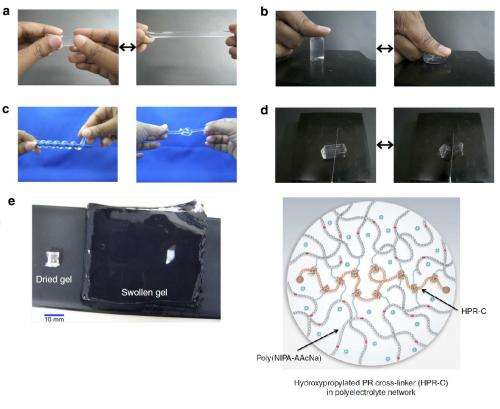October 22, 2014 feature
Extremely stretchable hydrogels may be used in artificial muscles

(Phys.org) —Hydrogels can reversibly change their size and shape under different conditions. This property makes them attractive for a wide variety of applications, including artificial muscles, drug delivery, and sensors. But even though stimuli-sensitive hydrogels have been studied for a few decades, they have not yet been commercialized for applications. One of the biggest problems is that they are usually weak and brittle, causing them to easily break when stretched.
Now in a new study published in Nature Communications, researchers at Nagoya University and The University of Tokyo have designed hydrogels with temperature and pH sensitivities that are extremely stretchable as well as mechanically strong. The improvements mark an important step toward enabling hydrogels to reach their full commercial potential.
All hydrogels are made of a polymer network and have a high water content. Many previous attempts have been made to improve the strength of hydrogels by modifying the polymer structure, but doing so often alters the stimuli sensitivities, as well.
The new hydrogel structure was inspired by recent research on a "slide-ring gel," in which molecules can slide through the holes in a figure-8-shaped junction of cross-linked polymers. This sliding is called the "pulley effect." By minimizing the stress on the polymer network, the pulley effect greatly strengthens the hydrogel.
Here, the researchers prepared a hydrogel with materials chosen specifically to exploit the pulley effect. They also introduced ionic sites in the polymer network, which increases stretchability and can be spatially distributed to regulate the pH dependence of the hydrogel's temperature response.
The resulting hydrogels exhibit many remarkable properties. They can be stressed, compressed, coiled, and knotted without breaking. The strong hydrogels also cannot be easily cut with a sharp knife. In addition, they can absorb large amounts of water, becoming 620 times heavier and gaining a much larger volume when placed in water.
"In my opinion, the greatest significance of our work must be that not only chemists but also many researchers in other fields such as physics, biology, and engineering can easily obtain the extremely stretchable hydrogels if they have the Polyrotaxane cross-linkers that we made," coauthor Yukikazu Takeoka at Nagoya University told Phys.org. "The preparation method of the hydrogels is quite identical to that for the traditional hydrogel used for electrophoresis. I hope that many researchers in many fields can use the extremely stretchable hydrogels for many research purposes."
The results demonstrate that making relatively minor modifications to the hydrogel polymer network can result in dramatic changes in its chemical properties. The preparation method is simple and general, allowing it to be applied to a wide variety of applications.
"Now we are studying the elastomers that do not contain any solvents, using the Polyrotaxane cross-linkers," Takeoka said. "I believe that we can obtain more stretchable elastomers using our cross-linkers."
More information: Abu Bin Imran, et al. "Extremely stretchable thermosensitive hydrogels by introducing slide-ring polyrotaxane cross-linkers and ionic groups into the polymer network." Nature Communications. DOI: 10.1038/ncomms6124
Journal information: Nature Communications
© 2014 Phys.org




















